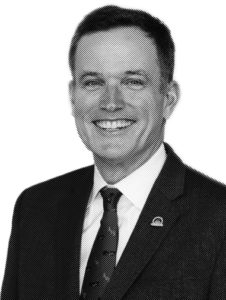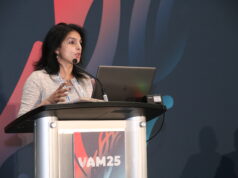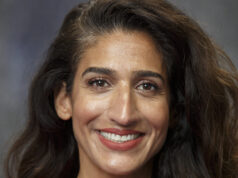
While there is little doubt the pandemic has impacted each vascular surgeon and the SVS as a Society in numerous ways, the commitment and dedication of SVS committee, council and task force members to deliver on the mission has remained undaunted. Thanks to outstanding leadership by the Executive Board and Strategic Board, and impeccable stewardship and professional support by our staff, the SVS has not lost a beat, and, if anything, is poised to step on the gas as some semblance of normalcy reappears. Despite incredible challenges in local practice conditions across the country, councils, committees and task forces kept meeting, thinking and producing results for members and patients.
SVS even generated some new committees and task forces during this challenging time, such as the Diversity Committee and the Population Health Task Force—reflective of the new opportunities for change on our horizon. I would like to take this opportunity to thank all of our SVS leaders, volunteers and staff for their steadfast commitment to our higher mission and cause as a Society. The reports presented show a vibrant, forward-looking Society, positioned to embrace whatever comes.—Ronald L. Dalman, MD, SVS president
New Year will bring new SVS online education portal
As part of the Education Council, the Education Committee is breaking new ground in 2021. Now more than ever, members need a place to go where all the educational programming of the SVS is available for them on one convenient, searchable website, says committee chair Kellie Brown, MD.
Starting in January 2021, the SVS will launch an online education portal, containing links to educational content developed through the SVS. This will be a one-stop place to find content from live and online events, Continuing Medical Education (CME) programs, and a video repository of surgical techniques peer-reviewed and curated by SVS members.
The portal will include links to several other websites, including a separate video library offering members a wide variety of videos on surgical techniques; and an SVS OnDemand site. The mobile-friendly SVS OnDemand will be accessible via single sign-on using SVS login credentials. Members will be encouraged to submit video and educational programs for sharing. This platform will grow over time to be the place to go for quality, peer-reviewed vascular content on the web.—Beth Bales
Education Council plans slew of advances—including new LMS
The Education Council—the umbrella for the Education, Leadership Development, Postgraduate Education, Resident and Student Outreach, VAM Program and VAM Video committees— has at least five goals for 2021, chair Rabih Chaer, MD, explains.
 These include planning and designing the next comprehensive member needs assessment for evaluation of results in 2021. This will be an all-encompassing survey designed to guide the strategic focus on the SVS based on the top priorities of the membership.
These include planning and designing the next comprehensive member needs assessment for evaluation of results in 2021. This will be an all-encompassing survey designed to guide the strategic focus on the SVS based on the top priorities of the membership.
The council also expects to release the inaugural version of the new learning management system (LMS), SVS OnDemand, to the membership, which is set to include repurposed VAM materials, hybrid education and a vascular atlas.
The LMS has been built by the hard work of the Education Committee with guidance from the Education Council. It will be a work in progress to enhance the vascular atlas, as well as the non-clinical sections, including leadership, wellness, and coding and billing. An editorial board for the new learning platform will be considered for maintenance and content update. This project is to launch this month.
There are also plans to develop a standardized methodology—as best practices—for the planning, development and implementation of skills courses, Chaer continues.
This is designed to ensure that the quality of the skills training remains high and reproducible. The council will oversee the effort of the SVS to implement skills courses, such as the peripheral arterial disease (PAD) and venous versions.
Chaer also drew reference to efforts being made to enhance educational platform offerings to include webinars and a virtual version of the PAD course. This will include webinars by highly sought-after experts on hot topics, and the virtual PAD course will be an abridged version of a future in-person course.
Finally, Chaer pointed to a multidisciplinary white paper of best practices in perioperative care—including vascular surgery, vascular medicine, anesthesia, SVS physician assistants and the Society for Vascular Nursing—that the council plans to release.
A draft of this document is in progress, and is designed to serve as a guide for practitioners on the perioperative care of different vascular pathologies and procedures. A mobile app version is also being developed and is aimed at acting as an easy reference resource.—Beth Bales and Bryan Kay
Going global: Society gets new International Mentorship Program
The International Relations Committee has launched a new International Mentorship Program to provide experienced SVS academic mentors for members outside the United States who do not have access to individuals who can assist them in professional growth.
Mentors will assist their mentees in clinical research design, abstract submission, manuscript preparation and scientific meeting presentations. Mentorship will not include specific patient care recommendations.
Outcomes of this effort include the mentee’s participation in presentations and publications, participation in the SVS International Scholars program and annual surveys sent to participants to evaluate process and success, says committee chair Palma Shaw, MD. “Continuous feedback can allow for improved process and outcomes,” she explains. “This effort will strengthen the visibility and interaction of the international membership, and generate academic productivity of higher quality. Interactions between the mentor and mentee can occur via Skype or other media platforms.”
The SVS website now includes an International Mentor Program toolbox for global members.
The tools include guidelines for standardized curriculum vitae (SUNY Upstate Medical University) and a quick guide to American Medical Association (AMA) citation style, Shaw reports. It also contains the Case Report Guidelines (CARE) checklist of information to include when writing a case report; guidelines for writing an abstract; the STROBE (Strengthening the reporting of observational studies in epidemiology) statement on observational studies; as well as case‐control, cohort and cross‐sectional studies, Shaw adds.
Furthermore, the CONSORT (Consolidated standards of reporting trials) 2010 statement—updated guidelines for reporting parallel group randomized trials is in the toolbox, along with CONSORT for abstracts—a checklist; the PRISMA (Preferred reporting items for systematic reviews and meta-analyses) checklist; practical non‐clinical skills for surgeons; a surgery trainee’s guide to writing a manuscript; and Journal of Vascular Surgery author information.
For information on the mentor program and toolbox, visit vsweb.org/ InternationalMentors.—Beth Bales
Furthering diversity goals in SVS appointments
The SVS Appointments Committee has made great efforts to be more transparent, diverse and equitable in recent years—a process its chair and members plan to continue.
 Improvements undertaken in the last four years include requiring more specific interest statements from candidate volunteers, leveraging chair and staff evaluations to judge performance and the fit of existing appointments, and enhanced attention to SVS diversity and inclusion metrics in the appointments process, committee member and SVS president Ronald L. Dalman recently noted.
Improvements undertaken in the last four years include requiring more specific interest statements from candidate volunteers, leveraging chair and staff evaluations to judge performance and the fit of existing appointments, and enhanced attention to SVS diversity and inclusion metrics in the appointments process, committee member and SVS president Ronald L. Dalman recently noted.
Traditionally, the committee consists of three members including the president, president-elect (Ali AbuRahma, MD) and vice president (Michael C. Dalsing, MD), with the president-elect as chair.
However, the Executive Board has expanded the committee’s composition to reflect diversity, equality and inclusion. So three members were added to the present composition: one from the Diversity, Equity and Inclusion Committee, one from the Community Practice Committee, and one representing the younger generation of the SVS membership. Among its appointments process activities, the committee works to ensure no single member is burdened with too many assignments. “Our goal is to make the process as transparent, inclusive and equitable as possible,” Dalman said. “Great progress has been made towards these goals, but there still is much more to do.”—Bryan Kay and Beth Bales
Overseeing governance and expanding SVS footprint
The Policy and Advocacy Council is composed of the leaders of the Coding and Reimbursement, Government Relations, PAC, Quality and Performance Measures, and VA Vascular Surgeons committees.
In effect, the umbrella body supports each of the committees, coordinating efforts across them and communicating on their behalf to the Executive Board, says council chair Matthew Sideman, MD.
In 2021, the council aims to actively pursue expanding the footprint of the Society for Vascular Surgery (SVS) as influential leaders in healthcare policy. “We will identify national volunteer leadership opportunities for our members and advocate for their placements to achieve this goal,” explains Sideman.—Beth Bales
Partnering with SVS PAC in fight over payment cuts
As 2020 brought both the prospect of significant reimbursement challenges for surgical services as well as the tremendous clinical and financial challenges of the pandemic, the SVS Government Relations Committee focused intensely on efforts to head off implementation of steep cuts to 2021 Medicare reimbursements.
 In 2021, chair Margaret Tracci, MD and the committee will continue to work closely with the SVS PAC and partners at the Surgical Care Coalition for appropriate reimbursement for vascular surgery care—a fight bound to continue even in the event of a “fix” in the final days of the 2020 legislative session, says Tracci. “We will also continue to advocate for policies that impact the quality of life and well-being of vascular surgeons, including pushing back against prior authorization and other administrative burdens, and to ensure that our role and mission are represented in any of the broader healthcare reform efforts that may emerge in a new administration,” she says.—Beth Bales and Bryan Kay
In 2021, chair Margaret Tracci, MD and the committee will continue to work closely with the SVS PAC and partners at the Surgical Care Coalition for appropriate reimbursement for vascular surgery care—a fight bound to continue even in the event of a “fix” in the final days of the 2020 legislative session, says Tracci. “We will also continue to advocate for policies that impact the quality of life and well-being of vascular surgeons, including pushing back against prior authorization and other administrative burdens, and to ensure that our role and mission are represented in any of the broader healthcare reform efforts that may emerge in a new administration,” she says.—Beth Bales and Bryan Kay
*The January 2021 issue of Vascular Specialist, which contained this special feature, went to press prior to the news that the dates for VAM had been moved to August, and that Congress had moved to halt cuts to Medicare.












